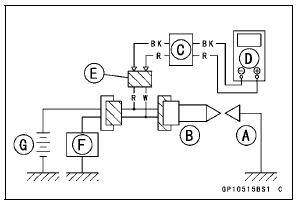

NOTE
Be sure the battery is fully charged.
Do not remove the spark plugs.

Install the new spark plug [A] into each stick coil [B], and ground them onto the engine.
Connect the peak voltage adapter [C] into the hand tester [D] which is set to the DC 250 V range.
Connect the adapter to the lead wire-peak voltage adapter [E] which is connected between the stick coil connector and stick coil.
ECU [F] Battery [G]
Special Tools - Hand Tester: 57001-1394 Peak Voltage Adapter: 57001-1415 Type: KEK-54-9-B Lead Wire-Peak Voltage Adapter: 57001 -1449

Connections: Adapter (R, +) → Lead Wire-Peak Voltage Adapter (W) Adapter (BK, –) → Lead Wire-Peak Voltage Adapter (R)
| WARNING To avoid extremely high voltage shocks, do not touch the spark plugs or tester connections. |
Stick Coil Primary Peak Voltage Standard: 100 V or more
If the reading is less than the specified value, check the following.
Stick Coils (see Stick Coil Inspection) Crankshaft Sensor (see Crankshaft Sensor Inspection) ECU (see ECU Power Supply Inspection in the Fuel System (DFI) chapter)
Spark Plug Removal
Refer to the Spark Plug Replacement in the Periodic Maintenance chapter.
Spark Plug Installation
Refer to the Spark Plug Replacement in the Periodic Maintenance chapter.
 Stick Coil Inspection
Stick Coil Inspection Spark Plug Condition Inspection
Spark Plug Condition InspectionBall Bearing and Needle Bearing
Do not remove pressed ball or needle unless removal is
absolutely necessary. Replace with new ones whenever
removed. Press bearings with the manufacturer and size
marks facing out. Press the bearing into place by putting
pressure on the correct bearing race as shown.
Pressing the incorrect ra ...
Fuse Inspection
Remove the fuse.
Inspect the fuse element.
If it is blown out, replace the fuse. Before replacing a
blown fuse, always check the amperage in the affected
circuit. If the amperage is equal to or greater than the
fuse rating, check the wiring and related components for
a short circuit.
...
What Are The Dealership’s Responsibilities?
Your Kawasaki dealer offers a wide range of services, parts, accessories, and
information on your product and on Kawasaki.
Each dealer is independently owned and operated and is responsible for the
dealership’s
operations, its repair, warranty, and service work, and its personnel.
Your dea ...